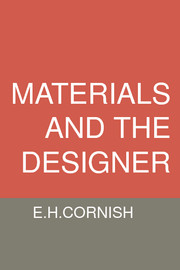Book contents
- Frontmatter
- Contents
- Preface
- Introduction
- 1 The impact of design on manufacturing industry
- 2 Expertise required for the design process
- 3 An introduction to materials
- 4 Properties of metals and alloys
- 5 Properties of ceramics
- 6 Properties of polymers
- 7 Properties of composites
- 8 Materials' performance in service
- 9 Finishes and coatings as protective systems
- 10 Materials reliability and service life
- 11 Factors controlling the selection of substitute materials
- 12 Material forming processes and design
- 13 Sources of information on materials
- 14 Standards and materials
- References
- Bibliography
- Index
- Frontmatter
- Contents
- Preface
- Introduction
- 1 The impact of design on manufacturing industry
- 2 Expertise required for the design process
- 3 An introduction to materials
- 4 Properties of metals and alloys
- 5 Properties of ceramics
- 6 Properties of polymers
- 7 Properties of composites
- 8 Materials' performance in service
- 9 Finishes and coatings as protective systems
- 10 Materials reliability and service life
- 11 Factors controlling the selection of substitute materials
- 12 Material forming processes and design
- 13 Sources of information on materials
- 14 Standards and materials
- References
- Bibliography
- Index
Summary
The need to know
Much of the world's wealth is the product of manufacturing industry. Even in instances where a valuable commodity is not specifically shaped into a manufactured product, as, for example, oil, minerals, diamonds or gold, nevertheless elements of engineering thought go into their processing and final presentation to a customer. However, the vast majority of manufactured goods represent the fruits of teamwork in industry, involving activity by planners as well as by machine operators. The artifacts with which we are all surrounded have been manufactured industrially on the basis of ideas from a variety of people. Being made of materials of one kind or another, it follows that the materials must have been selected by somebody. One purpose of this book is to help that somebody, be he a designer, a practising engineer, a student or whoever, to become more aware of the world of materials technology with which he has to be concerned.
In the twentieth century, no man can be an expert on all those aspects of a saleable article. Even though a craftsman whittling a wooden object may have a deep knowledge of the characteristics of wood as it responds to a sharpened carving tool, he will probably know little of the complex chemistry and biology of the material on which he is working.
- Type
- Chapter
- Information
- Materials and the Designer , pp. 1 - 6Publisher: Cambridge University PressPrint publication year: 1987



